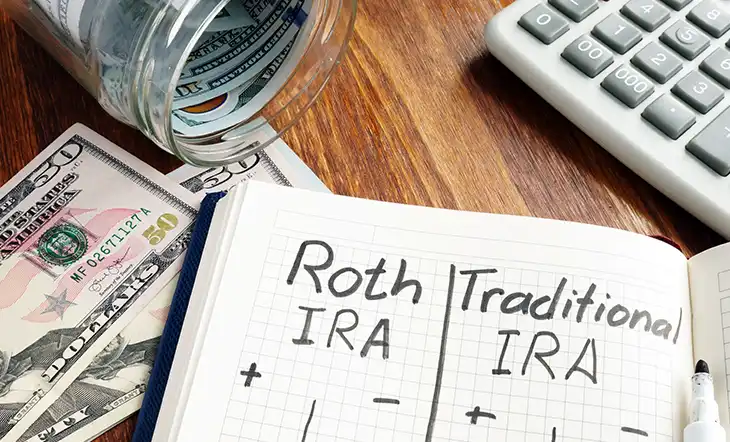Things to Consider When Deciding Between A Roth or Traditional Retirement Accounts

As of September 30, 2022, there were approximately $6.3 trillion in assets in 401(k) plans in the country. These assets represented the cumulative value of nearly 625,000 plans with 60 million active participants, among many former employees and retirees. The Individual Retirement Account (IRA) is an equally popular investment vehicle. An estimated 37% of households owned an IRA in 2021, with 28% who owned a Traditional IRA. IRAs had nearly $13.2 trillion in assets at the end of 2021’s third quarter, representing 35% of the total retirement market.
As widely used as these two accounts are, one of the biggest issues most investors face is in deciding between a Traditional and Roth account. Traditional and Roth 401Ks and IRAs can offer distinct tax benefits.
A financial advisor can help you understand these and choose a suitable account for your needs. This article also focuses on some key factors to consider when selecting the right 401k or IRA.
Table of Contents
- A. Roth IRA vs. a Traditional IRA
- Key differences between a Roth IRA and a Traditional IRA
- 1. They are taxed differently, and the timing of the tax benefits differs
- 2. They have different rules and penalties for early withdrawals
- 3. They have distinct distribution rules
- 4. Their income thresholds are not the same
- Roth IRA income limits in 2023
- Traditional IRA tax deduction limits in 2023
- Key similarities between a Roth IRA and a Traditional IRA
- 1. They have the same contribution limits
- B. Roth 401k vs. a Traditional 401k
- Key differences between a Roth 401k and a Traditional 401k
- 1. They are subjected to different tax rules
- Key similarities between a Roth 401k and a Traditional 401k
- 1. They have the same distribution rules
- 2. They have the same penalty and early withdrawal rules
- 3. They have the same contribution limits
- 4. They have the same loan process
- Common questions about Traditional and Roth accounts
- To conclude
- About Dash Investments
A. Roth IRA vs. a Traditional IRA
Roth IRA and Traditional IRA are both individual retirement accounts that offer tax advantages. However, there are some critical differences between the two.
Key differences between a Roth IRA and a Traditional IRA
1. They are taxed differently, and the timing of the tax benefits differs
The key difference between a Traditional IRA and a Roth IRA is the timing of the tax benefits. With a Traditional IRA, you get a tax break upfront but pay taxes on withdrawals during retirement. With a Roth IRA, you do not get a tax break upfront, but you do not pay any taxes on withdrawals during retirement.
Here’s how this works:
A Traditional IRA allows you to contribute your pre-tax dollars, which means that the money you contribute is not taxed until you withdraw it during retirement. The contributions you make towards a Traditional IRA are tax-deductible as per the prescribed limit. On the other hand, a Roth IRA allows you to contribute post-tax dollars, which means that you pay taxes on the funds you contribute upfront. However, when you withdraw the money during retirement, you do not have to pay any taxes on it, including any earnings you have accrued.
2. They have different rules and penalties for early withdrawals
Since you pay income tax on a Roth IRA at the time of contribution, you have no further tax liabilities. This enables you to withdraw your funds without any penalty or tax consequences anytime you want. A Traditional IRA is not as flexible as you still owe tax on your funds. The contributions are made tax-free, and you pay tax on your withdrawals. As a result, the Internal Revenue Service (IRS) monitors your withdrawals with certain rules according to which you are taxed and imposed with a 10% penalty on withdrawals made before the age of 59.5 and when the account has not been active for at least five years. Withdrawals post the age of 59.5 and from an account that has been active for at least five years are taxed but there is no penalty.
It is also important to know that the IRS offers some exemptions for premature distributions, such as:
- You can draw up to a limit of $10,000 to cover the costs of buying a home if you are a first-time homebuyer.
- You have been diagnosed with a total and permanent disability.
- You use the money to cover qualified higher education expenses.
- You need to pay health insurance premiums while unemployed, and others.
While you can still make early distributions from your Traditional IRA, you may incur a penalty and may have to pay tax. Hence, it is strongly advised first to understand the repercussions of your decisions and assess other options.
3. They have distinct distribution rules
A major difference between Roth and Traditional IRAs is that the latter has Required Minimum Distributions (RMDs). RMDs are mandatory withdrawals that owners must make from their accounts after a certain age. As of 2023, the age limit for RMDs has been fixed at 73. The value of each distribution is decided on the basis of your life expectancy and the total account balance. You must take your first RMD by April 1 of the year, after which you turn 73. Thereafter, all your subsequent RMDs should be withdrawn by December 31 of the concerned year. If you fail to withdraw your RMDs on time, you need to pay a 25% penalty of the required RMD value.
RMDs are put in place so the government can tax you on your distributions. Since a Roth IRA is not taxed in retirement, it does not have any RMDs. You can draw your money whenever you like. You also have complete autonomy over the value of your distributions. Moreover, you can choose not to withdraw your money too.
4. Their income thresholds are not the same
Roth IRA income limits in 2023
|
Tax filing status |
2023 Income |
Contribution |
| Single, head of household, or married taxpayers filing separately and not living with their spouse at any time during the last year | Less than $138,000 | Up to the annual limit |
| $138,000 to $153,000 | Begin to phase out | |
| More than $153,000 | Zero | |
| Married taxpayers filing separately and have lived with their spouse at some time during the last year | Less than $218,000 | Up to the annual limit |
| $218,000 to $228,000 | Begin to phase out | |
| More than $228,000 | Zero | |
| Married taxpayers filing jointly and qualifying widow(er) | Less than $10,000 | Begin to phase out |
| More than $10,000 | Zero |
Traditional IRA tax deduction limits in 2023
Traditional IRAs do not have any income limits, but they do have tax deduction limits.
|
Tax filing status |
2023 Income |
Deduction |
| Single, head of household, or married taxpayers filing separately and not living with their spouse at any time during the last year | Less than $73,000 | Full deduction up to the contribution limit |
| $73,000 to $83,000 | Partial deduction | |
| More than $83,000 | No deduction | |
| Married taxpayers filing separately and have lived with their spouse at some time during the last year | Less than $116,000 | Full deduction up to the contribution limit |
| $116,000 to $136,000 | Partial deduction | |
| More than $136,000 | No deduction | |
| Married taxpayers filing jointly and qualifying widow(er) | Less than $10,000 | Partial deduction |
| More than $10,000 | No deduction |
Key similarities between a Roth IRA and a Traditional IRA
1. They have the same contribution limits
Traditional and Roth IRAs have the same contribution limits. As of 2023, you can contribute up to $6,500 if you are under the age of 50. If you are 50 or older, you get a catch-up contribution of $1,000 and can contribute up to $7,500 in total.

Need a financial advisor? Compare vetted advisors matched to your specific requirements.
Choosing the right financial advisor is daunting, especially when there are thousands of financial advisors near you. We make it easy by matching you to vetted advisors that meet your unique needs. Matched advisors are all registered with FINRA/SEC.
Click to compare vetted advisors now.B. Roth 401k vs. a Traditional 401k
401k accounts also primarily differ on the basis of how they are taxed. Here are some things to know in detail:
Key differences between a Roth 401k and a Traditional 401k
1. They are subjected to different tax rules
A Traditional 401k allows you to make contributions from your pre-tax dollars but taxes you in retirement. On the other hand, a Roth 401k allows you to make contributions with your after-tax income, so you owe no tax in retirement.
A 401k may offer an employer match. The employer match is subjected to federal corporate income tax rules, and contributors/retirees are not impacted by them.
Key similarities between a Roth 401k and a Traditional 401k
1. They have the same distribution rules
An important point to note is that, unlike IRAs, 401ks have the same distribution rules for Traditional and Roth accounts. Both accounts have RMDs, and you must start them from the age of 73 as of 2023 to avoid a 25% penalty of the RMD value. However, if you wish to avoid the RMDs, you have the option to roll over your Roth 401k account to a Roth IRA.
2. They have the same penalty and early withdrawal rules
Traditional and Roth IRAs do not permit early withdrawals before the age of 59.5 years or until the account has been open and active for at least five years prior to the withdrawal. In the case of nonqualified withdrawals, you are subjected to a 10% penalty along with applicable taxes.
3. They have the same contribution limits
A traditional and Roth 401k both have the same contribution limits. As of 2023, you can contribute up to $22,500 if you are under the age of 50. If you are 50 or older, you get a catch-up contribution of $7,500 and can contribute up to $30,000 in total.
4. They have the same loan process
A 401k offers you the option to take a loan against your balance. The rules of the loan are the same for both types of accounts and are primarily determined by the plan administrator or employer.
Common questions about Traditional and Roth accounts
1. Can you have a Roth IRA and a Traditional IRA?
Yes, you can have both a Roth IRA and a Traditional IRA, and many people do. In fact, having both types of IRAs can be a smart strategy for managing your retirement savings and tax liability. Investing in the two accounts enables you to create tax diversification in your retirement savings. This means that you will have some retirement income that is tax-free (from the Roth IRA) and some retirement income that is taxable (from the Traditional IRA). Traditional IRAs require you to start taking withdrawals (RMDs) at age 73, while Roth IRAs have no RMDs during your lifetime. By having both types of IRAs, you can manage your RMDs and potentially reduce your tax liability in retirement.
No matter how many IRAs you own, your total contribution should never exceed the IRS annual limit for any year. If you contribute in excess, you will incur a penalty on the additional amount.
2. Should I contribute to a Roth IRA or a Traditional IRA?
The decision to choose between the two is a personal one and can be taken after careful assessment and evaluation of the two accounts. Each of them can offer unique advantages. You can consult a financial advisor to understand them and arrive at a decision. A financial advisor can help you develop a retirement savings strategy with the right account that takes into consideration your individual circumstances.
3. Can you have a 401k and an IRA together?
Yes, you can have a 401k (Traditional or Roth) and an IRA (Traditional or Roth) at the same time. A 401k is an employer-sponsored account that is offered to you by the company you work for. If you feel you do not have enough investment options or flexibility in it, you can consider opening an IRA on the side. An IRA can be opened with a broker, insurance company, union, etc., and may have greater flexibility in choosing the type of plan and investments.
An IRA has relatively low contribution limits that can limit your retirement savings. A 401k may allow you to make thrice the investments as an IRA. An IRA, in this regard, can serve as an additional cushion to your overall retirement plan. However, managing two accounts may be time-consuming.
To conclude
Deciding between a Traditional or Roth retirement account depends on your individual financial situation and tax bracket. A Traditional account allows you to contribute pre-tax dollars and reduce your taxable income, while a Roth account allows for tax-free withdrawals in retirement. Both types of accounts may have contribution limits, penalties, distributions, etc., that you need to pay attention to. It is also possible to have both types of accounts as long as you stay within the annual contribution limit and are able to manage them effectively. Seeking the advice of a financial advisor can help you make an informed decision about which type of retirement account is best for your individual needs and goals.
WiserAdvisor’s free advisor match service can be a convenient way to find a financial advisor in your area who aligns with your requirements and investment attitude. Answer a few simple questions based on your financial needs, and the match tool will help connect you with 1-3 financial advisors that are best suited to help you.
For additional information on retirement planning strategies that can be tailored to your specific financial needs and goals, visit Dash Investments or email me directly at dash@dashinvestments.com.
About Dash Investments
Dash Investments is privately owned by Jonathan Dash and is an independent investment advisory firm, managing private client accounts for individuals and families across America. As a Registered Investment Advisor (RIA) firm with the SEC, they are fiduciaries who put clients’ interests ahead of everything else.
Dash Investments offers a full range of investment advisory and financial services, which are tailored to each client’s unique needs providing institutional-caliber money management services that are based upon a solid, proven research approach. Additionally, each client receives comprehensive financial planning to ensure they are moving toward their financial goals.
CEO & Chief Investment Officer Jonathan Dash has been profiled by The Wall Street Journal, Barron’s, and CNBC as a leader in the investment industry with a track record of creating value for his firm’s clients.

Jonathan Dash is the Founder of Dash Investments. As Chief Investment Officer, he is responsible for all the investment management and asset allocation decisions at the firm. With over 25 years of experience in investment management, Mr. Dash has an established reputation as a superior money manager. Dash Investments has been covered in major business publications such as Barron’s, The Wall Street Journal, and The New York Times. Mr. Dash graduated from the University of Southern California with a B.S. in Finance and has also completed numerous executive programs at both Harvard Business School and Columbia Business School covering corporate restructuring, mergers and acquisitions, financial analysis and valuation. Jonathan Dash 800-549-3227
Related Article
7 min read
20 Sep 2023
What is a Vested Balance In Your Retirement Account?
In retirement planning, the concept of vesting is more than a contractual formality; it serves as a retention tool that incentivizes employees to remain with their employer for a certain period. By implementing vesting schedules for employer-contributed funds, organizations aim to foster long-term commitment and reduce employee turnover. Against this backdrop, understanding your vested balance […]
10 min read
13 Sep 2023
The Most Important Factor You’re Probably Overlooking In Your Retirement Planning
While grappling with various aspects of retirement planning, it is imperative to acknowledge a critical factor that often does not receive its due attention – longevity risk. Longevity risk refers to the risk that people are living longer lifespans than previous generations. Additionally, this trend is expected to continue in the future. While this is […]
9 min read
08 Sep 2023
Delay These 7 Actions Until Your Retirement Is Finalized
Most people feel a sense of anticipation and excitement before retirement. These are the golden years when you can finally reap the rewards of decades of hard work and have the freedom to travel, socialize, and pursue your passions. Yet, amidst the joy and delight, it is vital to remember that the journey to retirement […]
10 min read
06 Sep 2023
How Often Should You Check Your Retirement Account Balance?
Maintaining a balanced approach is critical in financial planning. Overindulgence in information can lead to poor decisions, and excessive monitoring of your retirement account balance can result in stress. This, in turn, can push you to make reactive choices that may not always work in your favor. Checking your retirement account balance too often can […]
More From Author
13 min read
30 Sep 2021
Questions To Ask Your Financial Advisor About Retirement
Retirement is the golden period of your life, provided you save well for it. If you have sufficient retirement savings, you can spend your non-working years traveling, enjoying life, spending time with your family, and doing anything else you like. However, if your retirement savings are below the required limit (average Americans feel they require […]
11 min read
14 Jul 2021
A Retirement Planning Guide for High-Net-Worth Individuals
Planning for retirement is an important component of everyone’s financial planning, including that of a high-net-worth individual (HNWI). Table of ContentsWhat is a high net worth individual (HNWI)?What is a ultra high net worth individual (UHNWI)?1. Understand your unique financial needs:2. Plan to make your money last longer:3. Manage your investments and risk:4. Minimize your […]
10 min read
25 Jul 2022
Financial Planning for High-Net-Worth Individuals
Financial planning can be helpful in many ways. It can help you save more, invest smartly, and find ways to increase your income sources. It is an integral part of any individual’s life, irrespective of factors like income, age, profession, etc. Financial planning adds discipline to your routine. It gives your goals a direction and […]
10 min read
06 Nov 2025
Determining Risk and Understanding the Risk Pyramid
When you begin investing, there are a few key checks to run. The first is to define your financial goals clearly. Without knowing what you are investing in, it can be rather tricky to choose the right strategy. The second step is to look at your time horizon. Are your goals short-term, medium-term, or long-term […]

Find & Compare Top Financial
Advisors in your area
Get Started
Popular Posts
Categories
- Business Finance (2)
- Education Planning (31)
- Estate Planning (31)
- Financial Advisor (1)
- Financial Advisor Guide (54)
- Financial Planning (138)
- Investment Management (100)
- Personal Finance (15)
- Portfolio Management (1)
- Retirement (28)
- Retirement Healthcare (1)
- Retirement Planning (111)
- Retirement Plans (1)
- Uncategorized (2)
Subscribe to our
newsletter & get helpful
financial tips.
The blog articles on this website are provided for general educational and informational purposes only, and no content included is intended to be used as financial or legal advice. A professional financial advisor should be consulted prior to making any investment decisions. Each person’s financial situation is unique, and your advisor would be able to provide you with the financial information and advice related to your financial situation.



